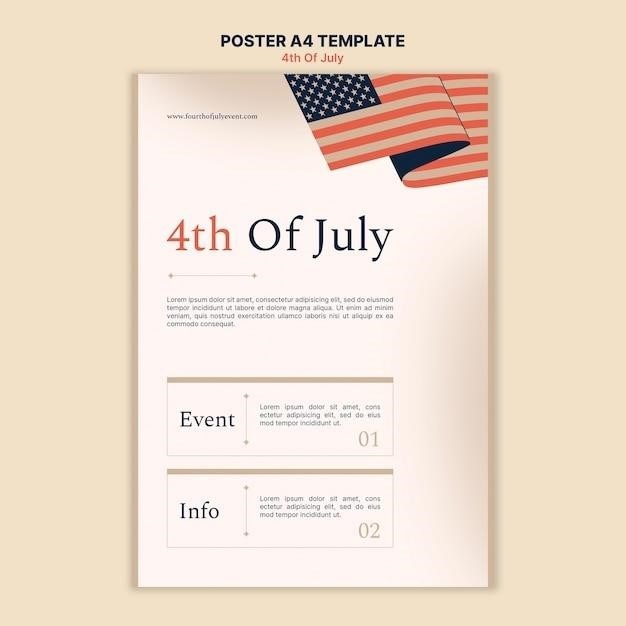The American President Movie Guide⁚ A Comprehensive Overview
This guide offers a detailed analysis of the 1995 film “The American President,” exploring its plot, characters, political satire, romance, and enduring relevance. It includes discussion questions, an answer key (available as a PDF), and comparisons to real-life presidential experiences, providing a deeper understanding of the movie’s themes and impact.

Key Plot Points and Character Analysis
The American President centers on President Andrew Shepherd, a widowed president grappling with his demanding job and the complexities of public life. A key plot point involves his unexpected romance with Sydney Ellen Wade, a lobbyist who initially clashes with his political stances. Their relationship unfolds against the backdrop of a crucial environmental bill, creating tension and conflict. Shepherd’s political opponents, notably Senator Bob Rumson, exploit the romance to undermine his presidency. The film explores the challenges of balancing personal life and public duty, highlighting the intense scrutiny faced by political figures. Key supporting characters include A.J. MacInerney, Lewis Rothschild, and Leon, who navigate the intricacies of the White House and offer diverse perspectives. The character analysis reveals the strengths, weaknesses, and motivations of each individual, offering insight into their decision-making processes and the impact of their actions on the narrative’s trajectory. The interplay between personal ambition and public service is a central theme explored through the characters’ actions and interactions. The movie’s climax hinges on the passage of the environmental bill, symbolizing the triumph of personal values over political expediency. The film’s ending provides a sense of resolution, but leaves the audience to ponder the ongoing challenges of leadership and the delicate balance between personal happiness and public responsibility.
The President’s Portrayal of Various Roles
President Andrew Shepherd’s portrayal in “The American President” showcases the multifaceted nature of the presidential office. The film highlights his roles as chief executive, commander-in-chief, party leader, and head of state. As chief executive, Shepherd presides over cabinet meetings, makes critical policy decisions, and manages the executive branch. His role as commander-in-chief is subtly depicted, primarily through his engagement with national security matters and his interactions with his advisors. As party leader, Shepherd navigates the political landscape, working with his party and dealing with opposition forces. His role as head of state involves representing the nation on the international stage, though this aspect is not extensively detailed in the film. The movie also emphasizes Shepherd’s role as a father figure, balancing his public duties with his personal life, demonstrating the challenges of leadership in the context of personal relationships. The film cleverly uses his actions in these roles to reveal his character and beliefs. Further, it explores the inherent conflicts that may arise when attempting to reconcile personal and public life. His struggles to maintain his integrity and his relationships whilst facing political pressures form a significant part of the narrative. The narrative effectively explores the complexities and responsibilities associated with the American presidency. Ultimately, Shepherd’s portrayal offers a nuanced perspective on the demands and pressures of the highest office in the land.
Analysis of Political Satire and Commentary
“The American President” masterfully employs political satire to comment on the American political system. The film satirizes the often-cynical nature of political campaigning, particularly through the character of Bob Rumson, the opposing Senator. Rumson’s negative campaigning tactics and manipulative rhetoric serve as a critique of the prevalent use of divisive strategies in modern politics. The movie also subtly satirizes the influence of lobbying and special interest groups, as highlighted by Sydney Ellen Wade’s initial role as a lobbyist. The film’s portrayal of the White House staff and their interactions with the President provides a humorous yet insightful look into the inner workings of the executive branch, often showcasing the bureaucratic hurdles and political maneuvering involved in policy-making. Furthermore, the movie’s depiction of the media’s role in shaping public opinion and the 24-hour news cycle offers a commentary on the relentless scrutiny and potential biases inherent in modern media coverage. Through witty dialogue and cleverly crafted scenarios, the film gently mocks the political process while simultaneously conveying the significant challenges and responsibilities faced by those in power. This blend of humor and social commentary allows the audience to engage with complex political issues in an accessible and entertaining manner.
Themes of Romance and Public Scrutiny
A central theme in “The American President” is the complex interplay between romance and the intense public scrutiny faced by a president. The film explores the challenges of maintaining a personal relationship while constantly being under the media’s gaze. President Andrew Shepherd’s romance with Sydney Ellen Wade, a lobbyist, highlights the inherent conflicts of interest and ethical considerations that arise when a powerful figure engages in a personal relationship. The movie depicts the media’s relentless pursuit of information, often blurring the lines between public interest and invasion of privacy. The intense media coverage of their relationship underscores the pressures and compromises involved in navigating a personal life within the public sphere; The narrative cleverly juxtaposes the intimate moments of Shepherd and Wade’s budding romance with the political maneuvering and public appearances demanded of the President. This juxtaposition creates a compelling tension, showcasing the sacrifices and complexities of balancing a private life with the demanding responsibilities of the highest office. The film ultimately suggests that genuine connection and personal fulfillment can exist even amidst the formidable pressures of public life, yet such a balance requires considerable compromise and resilience from those involved.
Discussion Questions and Activities
To enhance understanding and encourage critical thinking, this movie guide includes a range of discussion questions and engaging activities. Consider these prompts⁚ How does the film portray the challenges of balancing public life with personal relationships? Analyze the portrayal of the media and its influence on the President’s decisions and personal life. Discuss the ethical dilemmas faced by the President and his staff. Explore the film’s commentary on political processes, lobbying, and campaign strategies. Consider the effectiveness of the President’s communication style and his ability to connect with the public. Compare and contrast the film’s portrayal of political life with your understanding of real-world politics. For activities, consider creating a mock debate based on the film’s central issues. Students could also write persuasive essays arguing for or against the President’s policies. Alternatively, role-playing scenarios could allow students to simulate interactions between the President, his staff, and lobbyists. These engaging activities aim to facilitate deeper engagement with the film’s themes and promote thoughtful discussion among students.

Answer Key for Movie Guide Questions
A comprehensive answer key is provided to facilitate a thorough understanding of the film and its complexities. This key is designed to complement the discussion questions and activities, offering detailed explanations and insightful analysis of the movie’s key moments and themes. The answers are crafted to not only provide correct responses but also to stimulate further thought and discussion. The key addresses questions about character motivations, plot developments, and the film’s underlying political and social commentary. It offers in-depth explanations for each question, unpacking the nuances of the narrative and its implications. The format is designed for ease of use, ensuring that both educators and students can readily access and comprehend the information provided. The answer key is an invaluable resource for those seeking to delve deeper into the film’s multiple layers and gain a more profound appreciation for its artistic merit and social relevance. It enhances the learning experience by providing clarity and fostering deeper engagement with the film’s themes.
Availability of the Answer Key PDF
The convenience of a downloadable PDF format ensures accessibility and ease of use for the answer key. This digital format allows for effortless distribution to students and educators alike, eliminating the need for cumbersome printing or photocopying. The PDF is designed for compatibility across various devices, ensuring seamless access regardless of the platform used. Users can easily download and save the document for future reference, ensuring that the valuable resource remains readily available. The digital nature of the PDF contributes to cost-effectiveness by eliminating the expenses associated with traditional printing and distribution methods. The readily available PDF answer key streamlines the process of assessing comprehension and facilitating meaningful discussions about the film. This ensures a smooth and efficient learning experience, maximizing the educational benefits of the “American President” movie guide. The PDF’s portability allows for convenient use in various learning environments, both inside and outside the classroom.
Comparison to Real-Life Presidential Experiences
The fictional presidency depicted in “The American President” offers fertile ground for comparing and contrasting with actual presidential experiences throughout US history. The film’s portrayal of a president balancing personal life with the immense pressures of the office invites reflection on the public and private lives of real-life presidents. Consider the challenges faced by leaders navigating complex relationships while simultaneously making crucial national decisions. The movie’s depiction of political maneuvering and legislative battles can be analyzed against the backdrop of actual political events and the successes and failures of specific presidential administrations. Students can explore how the film’s portrayal of public opinion and media scrutiny aligns with or differs from the realities of presidential leadership in the modern era. Comparing the film’s depiction of presidential decision-making with real-world examples can highlight the complexities and consequences of such decisions. By drawing parallels and distinctions, viewers gain a richer understanding of the challenges and rewards of the presidency, both as portrayed in the film and as experienced in reality.
Enduring Relevance and Legacy of the Film
Despite being released in 1995, “The American President” maintains surprising relevance. Its exploration of political compromise, the clash between personal values and political expediency, and the enduring power of romantic love continues to resonate with audiences. The film’s sharp political satire, though rooted in the 1990s, speaks to timeless issues of political discourse and the challenges of leadership. The themes of public image versus private reality, the pressures of constant media scrutiny, and the tension between personal ambition and public service remain strikingly pertinent. The film’s legacy lies not only in its entertainment value but also in its ability to spark discussions about the nature of political leadership, the importance of effective communication, and the human cost of public service. Its enduring popularity suggests a continued interest in exploring these complex issues through the lens of a well-crafted narrative, making it a valuable tool for education and discussion even today. The film’s clever dialogue and compelling characters ensure its continued place in cinematic and political discussions.